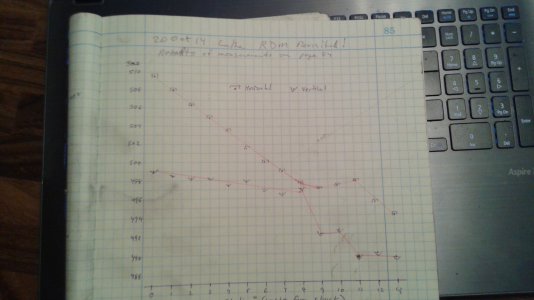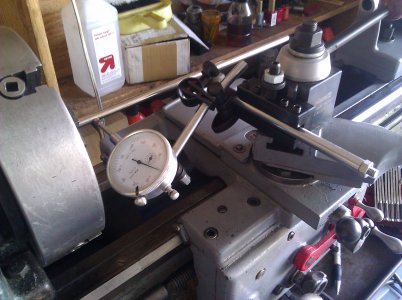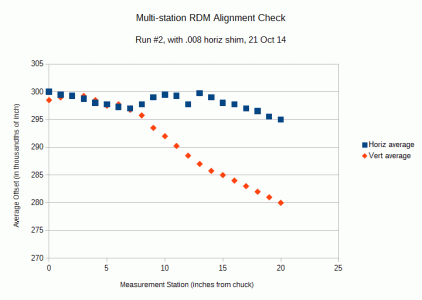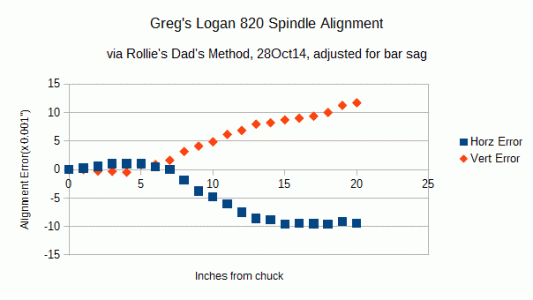Re: Greg's Logan 820 Restoration - Rollie's Dad's Method for Spindle Alignment, enhanced version
Redlineman and the gang,
The Logan 820 has a spindle bore of 0.781, so I got a new piece of 3/4" drillr od and cut off a 2 foot piece for a bigger test rod. Bigger is better since it reduces inherent sag in the rod itself. According to my calculations, 13"of 1/2 rod will sag 0.0022, but 3/4 rod will only sag 0.001. But my new 24" rod may sag 0.011 at the end. And the heavy rod may sag more inside my elderly 8" 4-jaw chuck. In retrospect, I should have super torqued the jaws before today's run!
Here are the old 1/2 rod and the new 3/4 one, ready to go.
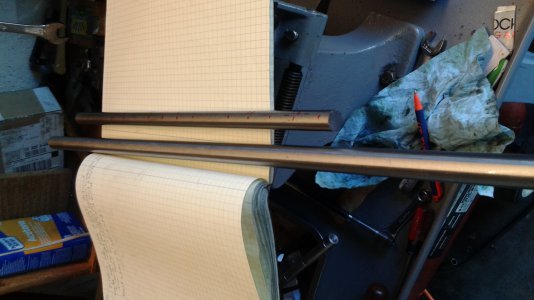
But today's work primarily focused on the horizontal alignment. Based on yesterday's graph, which showed a horizontal error of 0.0177"/foot, I added an 0.008 shim under the right rear corner of the headstock's, on the front side of the vee-way, so as to skew the spindle axis forward.
I marked the rod at every inch, starting near the chuck (station 0) and running out to station 20. Remember yesterday's erratic readings around station 9, now I hope to get a better idea of what's going on. The rear side of the front carriage way did show a series of little marks in that region, you could barely feel them with a needle, but they are "microdents", maybe caused by chattering? Anyhow, I wiped down the ways and tighten all the gibs before today's measurements.
First the horizontal, now that the shim has been added. Here is how the horizontal measurements are done:
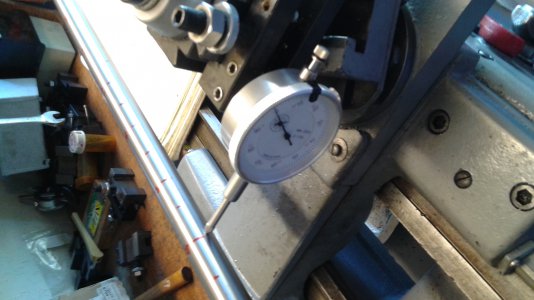
Starting at station 0, I crank the carriage in until I getting a nice round reading on the dial indicator such as 0.300, then turn the spindle until I find and record the high and low readings at that station. Today I made a spreadsheet to find the averages and plot them, (note: from here on, I will show numbers like 0.3015 as just "301.5")
Station Max Min Average
0 301.5 298.5 300
1
2
...
And so on: crank the carriage down to the next station, find and record the max and min. Every few inches, I make sure the dial indicator is still on the centerline of the rod. Because of the sag factor, I need to readjust the tool holder height a few times. Be careful not to bump the cross feed or compound cranks!
Then the vertical measurements: I change my tool holders to one with a vertically mounted dial indicator and repeat the station by station measurements of the max and min deflections in order to find the average deflection at each station.
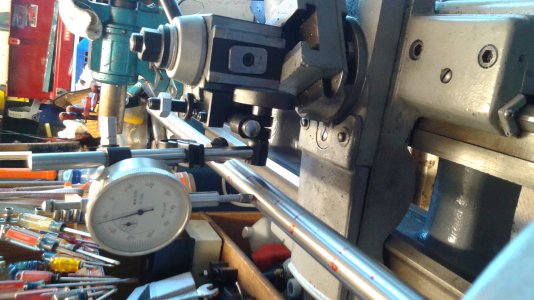
Here are today's results:
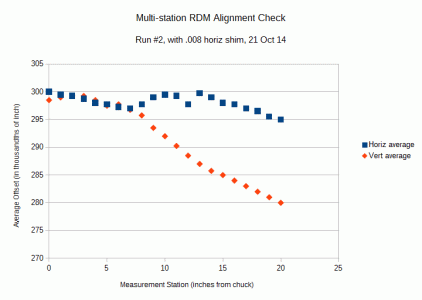
Analysis: The .008 shim has significantly improved the horizontal alignment, going from .0177"/foot of misalignment down to 0.0055"/ft. Therefore, I will add another .004 of shim and that should about zero it out. Note, these slopes are figured in the interval of stations 0 - 7, the nice linear portion. But despite the dips, the full 20"range is not too bad, it works out to 0.003"/ft of error (on average, ignoring the anomalies). I think I could live with that.
But the vertical error is much worse today Is it due to the fatter/longer bar not being clamped tight enough in the chuck?
Redlineman: Do you see what's going on here? Because I am not actually cutting the rod, having a long, thin piece sticking out of the chuck is not a real problem, especially in the horizontal plane. It is just the few grams of pressure from the dial indicator. The nice thing about RDM is that you don't need a perfectly straight rod, nor a perfect, zero-runout chuck. Because the readings are averaged, that accounts for these factors. But it doesn't account for sag, as mentioned earlier, and it doesn't account for variations in the diameter of the rod from station to station. Drill rod should be good, but I will mike it tomorrow, any variations can be compensated for in the spreadsheet if needed.
Tomorrow I have to teach a math class, but may get back into the shop and continue this epic.
Greg






